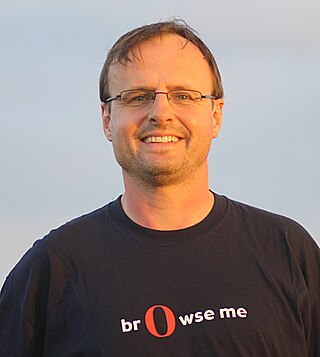Scalable Vector Graphics (SVG) is an XML-based vector image format for defining two-dimensional graphics, having support for interactivity and animation. The SVG specification is an open standard developed by the World Wide Web Consortium since 1999.

Vector graphics are a form of computer graphics in which visual images are created directly from geometric shapes defined on a Cartesian plane, such as points, lines, curves and polygons. The associated mechanisms may include vector display and printing hardware, vector data models and file formats, as well as the software based on these data models. Vector graphics are an alternative to raster or bitmap graphics, with each having advantages and disadvantages in specific situations.

The World Wide Web Consortium (W3C) is the main international standards organization for the World Wide Web. Founded in 1994 and led by Tim Berners-Lee, the consortium is made up of member organizations that maintain full-time staff working together in the development of standards for the World Wide Web. As of 5 March 2023, W3C had 462 members. W3C also engages in education and outreach, develops software and serves as an open forum for discussion about the Web.
Web colors are colors used in displaying web pages on the World Wide Web; they can be described by way of three methods: a color may be specified as an RGB triplet, in hexadecimal format or according to its common English name in some cases. A color tool or other graphics software is often used to generate color values. In some uses, hexadecimal color codes are specified with notation using a leading number sign (#). A color is specified according to the intensity of its red, green and blue components, each represented by eight bits. Thus, there are 24 bits used to specify a web color within the sRGB gamut, and 16,777,216 colors that may be so specified.
Web standards are the formal, non-proprietary standards and other technical specifications that define and describe aspects of the World Wide Web. In recent years, the term has been more frequently associated with the trend of endorsing a set of standardized best practices for building web sites, and a philosophy of web design and development that includes those methods.

Amaya is a discontinued free and open source WYSIWYG web authoring tool with browsing abilities.

Håkon Wium Lie is a Norwegian web pioneer, a standards activist, and the chairman of YesLogic, developers of Prince CSS-based PDF rendering software. He is best known for developing Cascading Style Sheets (CSS) while working with Tim Berners-Lee and Robert Cailliau at CERN in 1994. He was the chief technology officer of Opera Software from 1998 until the browser was sold to new owners in 2016.

Tantek Çelik is a Turkish-American computer scientist, currently the Web standards lead at Mozilla Corporation. Çelik was previously the chief technologist at Technorati. He worked on microformats and is one of the principal editors of several Cascading Style Sheets (CSS) specifications. He is author of HTML5 Now: A Step-by-Step Video Tutorial for Getting Started Today (ISBN 978-0-321-71991-1).

HTML5 is a markup language used for structuring and presenting hypertext documents on the World Wide Web. It was the fifth and final major HTML version that is now a retired World Wide Web Consortium (W3C) recommendation. The current specification is known as the HTML Living Standard. It is maintained by the Web Hypertext Application Technology Working Group (WHATWG), a consortium of the major browser vendors.

The Acid3 test is a web test page from the Web Standards Project that checks a web browser's compliance with elements of various web standards, particularly the Document Object Model (DOM) and JavaScript.

Web typography, like typography generally, is the design of pages – their layout and typeface choices. Unlike traditional print-based typography, pages intended for display on the World Wide Web have additional technical challenges and – given its ability to change the presentation dynamically – additional opportunities. Early web page designs were very simple due to technology limitations; modern designs use Cascading Style Sheets (CSS), JavaScript and other techniques to deliver the typographer's and the client's vision.
Animation of Scalable Vector Graphics, an open XML-based standard vector graphics format is possible through various means:

EPUB is an e-book file format that uses the ".epub" file extension. The term is short for electronic publication and is sometimes stylized as ePUB. EPUB is supported by many e-readers, and compatible software is available for most smartphones, tablets, and computers. EPUB is a technical standard published by the International Digital Publishing Forum (IDPF). It became an official standard of the IDPF in September 2007, superseding the older Open eBook (OEB) standard.

Web Compatibility Test for Mobile Browsers, often called the Mobile Acid test, despite not being a true Acid test, is a test page published and promoted by the World Wide Web Consortium (W3C) to expose web page rendering flaws in mobile web browsers and other applications that render HTML. It was developed in the spirit of the Acid test by the Web Standards Project to test the relevant parts that a mobile browser needs to support. The browser has to accomplish 16 different subtests indicated by a 4 x 4 image of green or red squares.

Cascading Style Sheets (CSS) is a style sheet language used for specifying the presentation and styling of a document written in a markup language such as HTML or XML. CSS is a cornerstone technology of the World Wide Web, alongside HTML and JavaScript.

The Arena browser was one of the first web browsers for Unix. Originally begun by Dave Raggett in 1993, development continued at CERN and the World Wide Web Consortium (W3C) and subsequently by Yggdrasil Computing. Arena was used in testing the implementations for HTML version 3.0, Cascading Style Sheets (CSS), Portable Network Graphics (PNG), and libwww. Arena was widely used and popular at the beginning of the World Wide Web.

Dave Raggett is an English computer specialist who has played a major role in implementing the World Wide Web since 1992. He has been a W3C Fellow at the World Wide Web Consortium since 1995 and worked on many of the key web protocols, including HTTP, HTML, XHTML, MathML, XForms, and VoiceXML. Raggett also wrote HTML Tidy and is currently pioneering W3C's work on the Web of Things. He lives in the west of England.
The Web platform is a collection of technologies developed as open standards by the World Wide Web Consortium and other standardization bodies such as the Web Hypertext Application Technology Working Group, the Unicode Consortium, the Internet Engineering Task Force, and Ecma International. It is the umbrella term introduced by the World Wide Web Consortium, and in 2011 it was defined as "a platform for innovation, consolidation and cost efficiencies" by W3C CEO Jeff Jaffe. Being built on The evergreen Web has allowed for the addition of new capabilities while addressing security and privacy risks. Additionally, developers are enabled to build interoperable content on a cohesive platform.
GSS in mathematics and computing, is an RDF vocabulary for representation of data in a model of labeled directed graph. Using it will make a relatively complex data resource modeled in RDF, much easier to understand by declaring simple styling and visibility instructions to be applied on selected resources, literals and properties.
The CSS Working Group is a working group created by the World Wide Web Consortium (W3C) in 1997, to tackle issues that had not been addressed with CSS level 1. As of December 2022, the CSSWG had 147 members.












